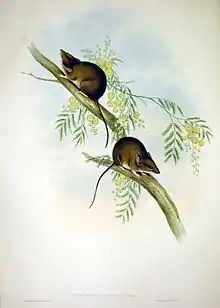| Dunnart | |
|---|---|
 | |
| White-footed dunnart (Sminthopsis leucopus) | |
| Scientific classification | |
| Domain: | Eukaryota |
| Kingdom: | Animalia |
| Phylum: | Chordata |
| Class: | Mammalia |
| Infraclass: | Marsupialia |
| Order: | Dasyuromorphia |
| Family: | Dasyuridae |
| Subfamily: | Sminthopsinae |
| Tribe: | Sminthopsini |
| Genus: | Sminthopsis Thomas, 1887 |
| Type species | |
| Phascogale crassicaudata Gould, 1844 | |
| Species | |
|
23, see text | |
Dunnart (from Noongar donat[1]) is a common name for species of the genus Sminthopsis, narrow-footed marsupials the size of a European mouse. They have a largely insectivorous diet.
Taxonomy
_(14559441713).jpg.webp)
Fat-tailed dunnart in its natural habitat.
The genus name Sminthopsis was published by Oldfield Thomas in 1887, the author noting that the name Podabrus that had previously been used to describe the species was preoccupied as a genus of beetles.[2] The type species is Phascogale crassicaudata, published by John Gould in 1844.
There are 19 species,[note 1] all of which occur in Australia and New Guinea:[3]
- Genus Sminthopsis
- S. crassicaudata species-group
- S. macroura species-group
- S. granulipes species-group
- S. griseoventer species-group
- S. longicaudata species-group
- S. murina species-group
- S. psammophila species-group
The genus is referred to by their common name of dunnarts.
Description
A male dunnart's Y chromosome is the smallest known mammalian Y chromosome.[4]
Notes
- ↑ The list is based on the Third edition of Wilson & Reeder's Mammal Species of the World (2005) except where both the Mammal Diversity Database and IUCN agree on the change.
References
- ↑ Abbott, Ian (2001). "Aboriginal names of mammal species in south-west Western Australia" (PDF). CALMScience. 3 (4): 450–451.
- ↑ Divljan, Anja; Ingleby, Sandy; Parnaby, Harry (6 January 2015). "Taxonomic status of Podabrus albocaudatus Krefft, 1872 and declaration of Sminthopsis granulipes Troughton, 1932 (Marsupialia: Dasyuridae) as a protected name for the White-tailed Dunnart from Western Australia". Zootaxa. 3904 (2): 283–292. doi:10.11646/zootaxa.3904.2.7. ISSN 1175-5334. PMID 25660785. S2CID 30027103.
- ↑ "Sminthopsis longicaudata". WA Museum Collections. 2017-02-14. Retrieved 2020-12-24.
- ↑ Toder R.; Wakefield M.J.; Graves J.A.M. (2000). "The minimal mammalian Y chromosome - the marsupial Y as a model system". Cytogenet Cell Genet. 91 (1–4): 285–92. doi:10.1159/000056858. PMID 11173870. S2CID 30401023.
External links
This article is issued from Wikipedia. The text is licensed under Creative Commons - Attribution - Sharealike. Additional terms may apply for the media files.